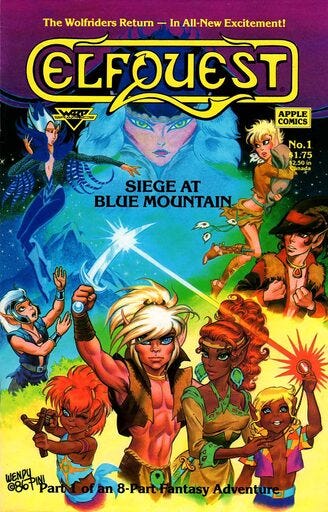
My Rating: ★★⯪☆☆
Intro & Summary
ElfQuest, by Wendy and Richard Pini, is different from the other Nostalgia Reads this year, in that it’s a comic instead of a novel. The Siege at Blue Mountain story spans 8 issues, which were collected into a hardcover edition. Nearly all of ElfQuest can be read (for free!) on the official website. I debated on whether or not to actually write up a review for this one, but here I am making an attempt.
Siege at Blue Mountain takes place after the first run of ElfQuest, now referred to as The Original Quest. The Wolfriders are living peacefully in their new home after the events of The Original Quest. This peace is disturbed by the arrival of Aroree, a Glider, who kidnaps one of the Wolfriders’ children and takes him to her master, the powerful Winnowill. With the help of humans and other allies, the Wolfriders infiltrate Winnowill’s fortress at Blue Mountain to thwart her schemes and rescue the child.
Growing up, M and I had a third friend, whom we’ll call R, that we’ve since sadly lost touch with. But it was R who had several of the ElfQuest hardcovers, and Siege at Blue Mountain is the one M and I both remember most, even though we know there were at least one or two others.
We all hung out together between the ages of about 8 and 12, and ElfQuest was THE most PG-13 thing any of us had ever read up to that point. As such, the strongest memories I had of Siege at Blue Mountain were that this comic contained depictions of nudity, sex and violence that I hadn’t encountered before in other media. But I didn’t remember a whole lot of the story itself. And that, combined with finding the issues readily (and legally) available online, prompted its addition to this year’s theme reading list.
Plot & Style
In this review, I want to focus on the writing and storytelling of ElfQuest rather than the art. But no matter my rating on that, the art is beautiful, especially in full colour, and the layout and flow of the comic pages was overall pretty good. I’d actually give the art 4/5. With that out of the way, let’s talk plot and (writing) style.
I struggled to get through Siege at Blue Mountain, due to a combination of it being a sequel series to a story I hadn’t read, very fantasy-esque language and… interesting pacing. All of this combined made it difficult for me to follow or get engaged with the story.
It’s important to note that I have very little experience with Western comics, from any era. I’m much more familiar with manga. So while I struggled with the pacing in particular, I’m not sure if that’s standard for Western comics or a unique part of ElfQuest. It wasn’t anything to do with panel layout. If this series was novelised, I think I still would have struggled to follow it. But again, I don’t know if this is a common style thing I’m just not used to, or if it’s just not for me in general.
The plot felt more like a short story sequel to something bigger, no doubt because Siege at Blue Mountain is only 8 issues, while The Original Quest spanned 21. As such, things happened quickly and wrapped up quickly, with little time for me to really get my bearings or get invested in any of the already-well-formed characters.
World and Characters
The world of ElfQuest is an interesting combination of fantasy, space/sci-fi and prehistoric. Among the elves, the Wolfriders live in the forest as a pack along with a number of wolves, the Sun Folk live in a desert oasis, and the Go-Backs live in the Frozen Mountains. There are faeries called Preservers, and the Gliders, who are direct descendants of the High-Ones, elves who came from space. The humans live in primitive tribal groups, with a technology level to match. In later issues, as the centuries advance, the humans advance as well, but in Blue Mountain they’re quite primitive. There are also trolls and other fantasy creatures as well.
Because of the short run of Blue Mountain and the fact that much was already established in The Original Quest, there isn’t much focus on the world, or even the characters. Some things are explained through narration, but for the most part I felt like I was left drifting in a foreign land where I barely spoke the language.
Again, the art is beautiful, but I don’t feel like I learned much about the world or characters through the story itself.
Final Ratings & Conclusion
Plot: 2/5
A sequel that requires foreknowledge of the series before it. Short and sweet but doesn’t really stand alone all that well.
World: 3/5
An interesting combination of fantasy, sci-fi and prehistoric times, but again relies on foreknowledge from the original series.
Characters: 2/5
As above, a foreknowledge of these characters is assumed, and none are really introduced in a good way for new readers, in my opinion.
Would I Read It Again?
No.
The art is beautiful, and the setting and world are intriguing, but I just couldn’t get into the story because of the way things were paced. It doesn’t really make me want to go back and read The Original Quest either. I want to like ElfQuest, but I think it stands better as a happy memory of hanging out with childhood friends and all the magic and wonder and fantasy we indulged in than as something I want to read.
Read: March 2025


